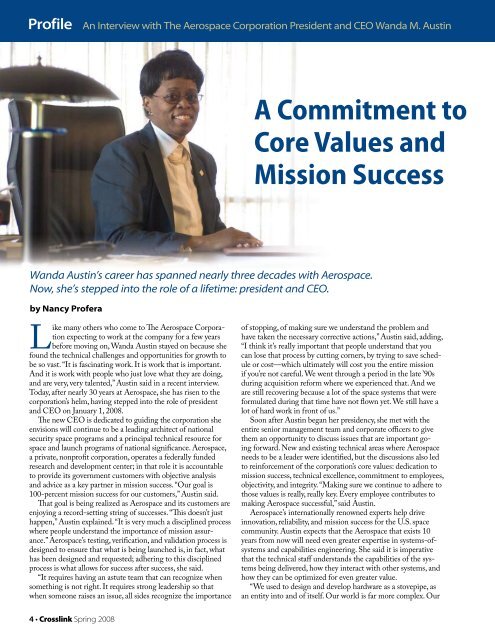Crosslink - Space-Library
Crosslink - Space-Library
Crosslink - Space-Library
You also want an ePaper? Increase the reach of your titles
YUMPU automatically turns print PDFs into web optimized ePapers that Google loves.
Profile An Interview with The Aerospace Corporation President and CEO Wanda M. Austin<br />
A Commitment to<br />
Core Values and<br />
Mission Success<br />
Wanda Austin’s career has spanned nearly three decades with Aerospace.<br />
Now, she’s stepped into the role of a lifetime: president and CEO.<br />
by Nancy Profera<br />
Like many others who come to The Aerospace Corporation<br />
expecting to work at the company for a few years<br />
before moving on, Wanda Austin stayed on because she<br />
found the technical challenges and opportunities for growth to<br />
be so vast. “It is fascinating work. It is work that is important.<br />
And it is work with people who just love what they are doing,<br />
and are very, very talented,” Austin said in a recent interview.<br />
Today, after nearly 30 years at Aerospace, she has risen to the<br />
corporation’s helm, having stepped into the role of president<br />
and CEO on January 1, 2008.<br />
The new CEO is dedicated to guiding the corporation she<br />
envisions will continue to be a leading architect of national<br />
security space programs and a principal technical resource for<br />
space and launch programs of national significance. Aerospace,<br />
a private, nonprofit corporation, operates a federally funded<br />
research and development center; in that role it is accountable<br />
to provide its government customers with objective analysis<br />
and advice as a key partner in mission success. “Our goal is<br />
100- percent mission success for our customers,” Austin said.<br />
That goal is being realized as Aerospace and its customers are<br />
enjoying a record-setting string of successes. “This doesn’t just<br />
happen,” Austin explained. “It is very much a disciplined process<br />
where people understand the importance of mission assurance.”<br />
Aerospace’s testing, verification, and validation process is<br />
designed to ensure that what is being launched is, in fact, what<br />
has been designed and requested; adhering to this disciplined<br />
process is what allows for success after success, she said.<br />
“It requires having an astute team that can recognize when<br />
something is not right. It requires strong leadership so that<br />
when someone raises an issue, all sides recognize the importance<br />
of stopping, of making sure we understand the problem and<br />
have taken the necessary corrective actions,” Austin said, adding,<br />
“I think it’s really important that people understand that you<br />
can lose that process by cutting corners, by trying to save schedule<br />
or cost—which ultimately will cost you the entire mission<br />
if you’re not careful. We went through a period in the late ’90s<br />
during acquisition reform where we experienced that. And we<br />
are still recovering because a lot of the space systems that were<br />
formulated during that time have not flown yet. We still have a<br />
lot of hard work in front of us.”<br />
Soon after Austin began her presidency, she met with the<br />
entire senior management team and corporate officers to give<br />
them an opportunity to discuss issues that are important going<br />
forward. New and existing technical areas where Aerospace<br />
needs to be a leader were identified, but the discussions also led<br />
to reinforcement of the corporation’s core values: dedication to<br />
mission success, technical excellence, commitment to employees,<br />
objectivity, and integrity. “Making sure we continue to adhere to<br />
those values is really, really key. Every employee contributes to<br />
making Aerospace successful,” said Austin.<br />
Aerospace’s internationally renowned experts help drive<br />
innovation, reliability, and mission success for the U.S. space<br />
community. Austin expects that the Aerospace that exists 10<br />
years from now will need even greater expertise in systems-ofsystems<br />
and capabilities engineering. She said it is imperative<br />
that the technical staff understands the capabilities of the systems<br />
being delivered, how they interact with other systems, and<br />
how they can be optimized for even greater value.<br />
“We used to design and develop hardware as a stovepipe, as<br />
an entity into and of itself. Our world is far more complex. Our<br />
4 • <strong>Crosslink</strong> Spring 2008
















